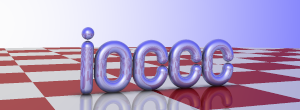Results of the 21st IOCCC competition
 The winners of the 21st international obfuscated C code competition were announced. As usual, the participants were surprised by the ability to cram absolutely incredible things into programs up to 4096 bytes. To get maximum pleasure, the organizers of the competition recommend watching the version without spoilers and trying to understand what the program does by the program code.
The winners of the 21st international obfuscated C code competition were announced. As usual, the participants were surprised by the ability to cram absolutely incredible things into programs up to 4096 bytes. To get maximum pleasure, the organizers of the competition recommend watching the version without spoilers and trying to understand what the program does by the program code.For example, what does such a program do?
main(l ,a,n,d)char**a;{ for(d=atoi(a[1])/10*80- atoi(a[2])/5-596;n="@NKA\ CLCCGZAAQBEAADAFaISADJABBA^\ SNLGAQABDAXIMBAACTBATAHDBAN\ ZcEMMCCCCAAhEIJFAEAAABAfHJE\ TBdFLDAANEfDNBPHdBcBBBEA_AL\ HELLO, WORLD! " [l++-3];)for(;n-->64;) putchar(!d+++33^ l&1);} Answer
That's right, prints a map of the world.

')
And not just prints, but also marks a place on the map (the symbol
By the way, this is the “best small program” at the 1992 IOCCC.

')
And not just prints, but also marks a place on the map (the symbol
" or # with coordinates that can be specified at launch).By the way, this is the “best small program” at the 1992 IOCCC.
The inventor of the binary lambda calculus, John Tromp, presented to the IOCCC competition the tromp.c program with a minimal implementation of the binary λ-calculus.
Int L[A],m,b,*D=A, *c,*a=L,C,*U=L,u;s (_){u--&&s(a=*a);} char*B,I,O;S(){b=b --?b:m|read(0,&I,1 )-1;return~I>>b&1; }k(l,u){for(;l<=u; UL<A?*U++=46^l++[ "-,&,,/.--/,:-,'/" ".-,-,,/.-,*,//..," ]:exit(5));}p(Int*m){ return!*U?*m=S()?U++,!S ()?m[1]=p(++U),2:3:1,p(U) :S()?U+=2:p(U[1]++),Um;}x( c){k(7*!b,9);*U++=b&&S();c&&x (b);}d(Int*l){--l[1]||d(l[d(*l), *l=B,B=l,2]);}main(e){for(k(10,33 ),a[4]-=m=e-2&7,a[23]=p(U),b=0;;e-2 ?e?e-3?s(D=a),C=a [3],++1[a=a[2]],d( D):c?D=c,c=*D,*D= a,a=D:exit(L[C+1]) :C--<23?C=u+m&1?O =O+O|C&1,9:write(m ||(O=C+28),&O,1)+ 1:(S(),x(0<b++?k(0, 6),U[-5]=96:0)):( D=B?B:calloc(4,X)) ?B=*D,*D=c,c=D,D[ 2]=a,a[++D[1]]++,D [3]=++C+u:exit(6) )e=L[C++],u=L[C];} However, he did not even enter the top three winners.
First place. Perfect obfuscation
zeitak.c
Very sophisticated obfuscated code. Even if you analyze the deobfuscated version of zeitak_deobfucate.c , it is very difficult to understand what it does.
Second place. The easiest use of C
hamano.c
Funny program encrypts texts on the dancing people algorithm, generating PDF files.
Well, the code of the program as it hints:
Code
#define \ D(s)"<<"#s">>" #define q(s)p(#s) #define S " endobj " #define Y "endstream"S #include <stdio.h> #define o(s) b[s]=_;\ p("%u 0 obj",s); #define E for (c=d;c < 123;c++) #define DANCE "trailer "D\ (/Root 3 0 R /Size %d) "\nstartxref %u %%%%EOF\n*/" #define p(s, ...) _+=printf(s, ##__VA_ARGS__) #define C "<</Type/Page /Parent %d %d R /Resources <<\ /ProcSet[ /PDF/Text]/Font <</U"D(/Subtype/Type1/BaseFont\ /Courier) " /T<</Subtype/Type3 /FontBBox[0 0 10 10]/FontMatrix[\ %f 0 0 %f 0 0]/FirstChar %d/LastChar %d/Encoding<</Differences[%d" typedef int N;typedef char*Nyan;typedef char A;N a,b[64],d=65,_,v [32]={84,0,64,282,90,74,330,85,93,173,167,176,80,208,81,13,7,87 ,160,346,32,128,170,218,16,26}; Nyan w[]={"+*-(,&-&","+*,&-&" ,"+*.&/&","+*/*/+","+*())'('" ,"+**&)&","+*(&'&","+*'*'+", "","+,./","+,-,./","+--,+*" ,"","+,(/","+,),(/","+-),+*" ,"10 0 d0 ","8 7 2 2 re " ,"+*+.'`'@'mi +/+/(mi"};Nyan nyan(Nyan _,N y,A n){ N g=v[~-y%32];Nyan s=w[g>>n&3|n*2]; for(a=0;*_=*s++; a++,_++,*_++=32) {*_+=*_-32?10:0; if(a%2&&*_/16==3 ){if(g>>8)*_=105-*_; _++;*_++=32;*_=~-a&&a-13 ?108:109;}}return n?n-9?nyan (_,y,n-2):_:nyan(_+=~y&' '?sprintf (_,17[w]):0,y,9);}N main(N c){A e[256]; p("/*%%PDF-1.3%%*/")-2;q(#include<stdio.h>\n); q(#define o *_++&& *_-41\n#define);p(" endstream ");q (main(){for(;*_++; *_-40?:putchar(o?*_:o?10:41));\n) ;q(#define endobj return 0;}\n);q(typedef int ET;/) ;q(*);o(1)*b=~(p(D (/Length 2 0 R)"stream\n")) ;for(p("BT 12 818" " Td/%c 12 Tf 12 TL%%%c/" "static char*_=\"" " \\\n",7[v],*v/2);c= getchar(),~c;c-10? p("/%c 12 Tf(\\%o)" "Tj",v[~-c%' '<25[ v]&&!~-(~-c/'@')?0 :7],c):(p("()'"))) ;p("%%\";\nET ");* b-=~_;p(Y"/*");E{a =nyan(e+sprintf(e, 16[w]),c,6)-e;o(c- 59)p(D(/Length %d) "stream\n%s"Y,a,e) ;}o(2)p(" %u"S,*b); o(3)p(D(/Pages 4 0 R)S);o(4)p(D(/Count 1/MediaBox[0 0 595 842]/Kids[5 0 R])S) ;o(5)p(C,4,0,6e-2, 6e-2f,d,122,d);E p( "/%c",~-c/6+~14?c: d);q(]>>/CharProcs<<) ;E if(~-c/6+~14)p( "/%c %d 0 R",c,c+~58); for(q(>>/Widths[), c=59;--c;p(" 10"));a=p ("]>>>>>>/Contents 1 0 R>>"S);for(p("xref\ 0 %d ",--d);c<d;p("%010u\ %05d n ",*(c+++b),NULL)); return!(p(DANCE,d,a));} Third place. Steganography
vik.c
A steganography application hides a PNG image or text inside another PNG image, and then pulls it back. The secret bits are added to the lower RGB values. As a bonus, the author provided an image of chocolate candies, which has a unique quality: after encoding and subsequent decoding, the code of a valid Brainfuck program appears in the image, and you can run it without a third-party interpreter.

Source: https://habr.com/ru/post/155335/
All Articles